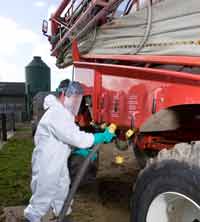Variably-applied growth regulator produces surprising results

Backward wheat crops may respond to a higher dose of plant growth regulator this spring than you might think.
Results of Syngenta trials investigating the potential benefits of proportionately dosing growth regulators according to crop density have suggested thin, backward crops respond more to higher doses of growth regulators than thicker crops.
The trials were set up to see whether variably applying growth regulators might have the same benefits as seen with fertilisers, the firm’s Tom Robinson says. “Many growers have seen how the ability to target fertiliser use according to crop potential helps reduce costs and increase yields,” he says.
The same principle – targeting inputs where they are needed most – applies to PGRs just as much as it does to fertiliser.
“If you know where your crop should be in terms of its development, you can give it a helping hand or hold it back, whichever is most appropriate,” he says.
The trials used satellite photos supplied by Soyl’s Sky Farm to measure and map how thick crops were in the same way leaf area index can be assessed at a certain growth stage. A PGR application plan based on variable rates can then be devised, Mr Robinson says.

Thinner crops might benefit from higher rates of growth regulators, Syngenta research suggests
The principles were tested in two fields of wheat at a Cambridge farm last year, with an objective of finding out how both types of crop responded to high and low rates of Moddus (trinexapac-methyl) to help determine how growth regulators could be variably applied.
So in both thick and thin parts of the field four different rates of Moddus were applied, ranging from nil to full dose (0.4 litres/ha).
The results were somewhat surprising. While overall yields for both the Timber and Xi19 were much higher in the thicker parts of the crop, regardless of growth regulator application, a much greater yield response was seen from high rates of Moddus in thin areas, Mr Robinson says.
That ranged from over 2t/ha in the Xi19 over the untreated parts to about 0.5t/ha in the Timber for the full-rate Moddus.
“It’s important to bear in mind this was just one trial,” he says. But it could be explained by Moddus’ ability to promote tillering and root growth in struggling crops, he suggests. “That’s very relevant to this season. There are a number of backwards crops out there, which can be given a kick-start with the right dose of PGR. For the majority, the helping-hand approach is needed.”
In contrast there was much less of a response on the more fertile areas, particularly in the Xi19. But no lodging occurred even in the untreated areas, he says.
Moddus’s role in forward crops is to keep them standing by preventing too much early stem extension.
Case Study: ‘It makes sense from a financial point of view’ |
|---|
For the past two years East Yorkshire grower John Porter, a self-precision farming advocate, has been using his N-Sensor machine to variably apply growth regulators. |

